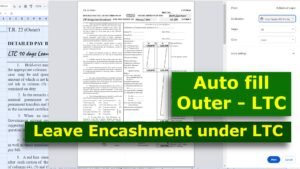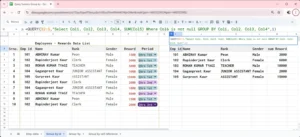
Guide to Managing Text Values and Date Data in Google Sheets
Google Sheets offers a range of data types, including text, numbers, and dates. Understanding the distinctions between these data types is crucial for efficient data management and analysis.
In Google Sheets, dates are stored as numerical “serial numbers,” starting with 30-Dec-1899 as the base date (value 0). Each subsequent day is represented by an increasing integer (e.g., 31-Dec-1899 = 1, 1-Jan-1900 = 2). This system allows you to perform calculations on dates as you would with regular numbers, while the display format automatically adapts to your chosen settings.

Alternatively, we can say that Google Sheets uses the 1900 date system, counting days from December 30, 1899 (excluding that date). For values between 0 and 1899, the system adds the value to 1900 to determine the year. For example, using the DATE function, DATE(125,2,1) generates the date February 1, 2025 (2/1/2025).
First Example:
- DATE(
125,2,1): - Year = 125 →
1900 + 125 = 2025. - Month = 2 → February.
- Day = 1 →
February 1. - Result:
February 1, 2025(2/1/2025).
If we take other example, DATE(99,17,11) calculates to May 11, 2008 (5/11/2008) because the month value overflows, adding extra months to the year. This parallel between row limits and date calculations illustrates Google Sheets’ systematic handling of data limits and numeric representations.
Second Example:
- DATE(
99,17,11): - Year = 99 →
1900 + 99 = 1999. - Month = 17 → Overflows into the following year (17 – 12 = 5, i.e.,
Mayof the next year). - Day = 11 →
May 11. - Result:
May 11, 2000(5/11/2000).
“Here, it is notable that the Google Sheets calendar popup is able to convert a value into a date up to -657433 (clickable in the popup), which corresponds to January 2, 0100 (02 January, 0100). While the calendar popup can display dates before January 2, 0100, it only shows the month’s data and does not allow these dates to be selected for entry into the cell.”

- The system supports dates up to 31-Dec-9999 (value 2,958,466). However, values beyond this, such as 01-Jan-10000 (value 2,958,467), are technically out of range and not clickable.
- While Google Sheets can displays large numbers as dates (e.g., 35,830,290 as 12/31/99999), these are not valid, interactive dates. If you double click on such a date, a calendar popup will appear.
- The calendar popup can display these or even larger dates (e.g., 35,830,290 as 12/31/99999), when you use the decrease or increase button. However, if you attempt to click on a specific date beyond the value 35,830,290 or date 12/31/99999,the calendar popup will no longer appear. Interaction is disabled for values beyond the supported range.
Below is a guide that explains how to handle text values, date values, and limitations of the Calendar popup in Google Sheets.
Understanding Date Values in Google Sheets
Base Date (30-Dec-1899):
Google Sheets (and Excel) uses 30-Dec-1899 as the “zero” point for its date system. This means:
- 30-Dec-1899 = 0
- 31-Dec-1899 = 1
- 01-Jan-1900 = 2
- 02-Jan-1900 = 3, and so on.
These numbers correspond to the days since 30-Dec-1899, making it the reference point for all subsequent dates.
Handling Time and Decimal Values
Google Sheets also represents time as fractional days. So, decimal numbers are valid and can be used for both time and date values.
For example:
- 1.5 represents 12:00 PM (Noon) on 31-Dec-1899.
- 2.25 represents 6:00 AM on 01-Jan-1900.
Limits on Date Values in Google Sheets
Google Sheets imposes limits on valid date values. These limits are defined by the serial number system used to represent dates.
Valid Date Range:
- 0 (30-Dec-1899) is the earliest date.
- 2,958,465 (31-Dec-9999) is the last valid date.
Out-of-Range Dates:
- 2,958,466 corresponds to 01-Jan-10000. While technically out of range, it is still displayable in Google Sheets Calendar popup.
- Numbers greater than 2,958,466 (such as 35,830,290) fall outside the date system’s range and cannot be interacted with via the calendar popup.
What Happens When Values Exceed the Date Range?
Values Above 2,958,466 (e.g., 2,958,467 and beyond):
These values are out of range for practical date calculations. Google Sheets will still show them as a date (e.g., 01-Jan-10000) but won’t allow you to interact with them in the calendar popup.
For extremely large values (e.g., 35,830,290):
Google Sheets will display the value as 12/31/99999, which is beyond the acceptable date range. While the date appears in the sheet, it is treated as a numeric value rather than a functional date, and you cannot interact with it in the calendar popup.
Behavior of the Calendar Popup
- Valid Dates:
You can interact with the calendar popup for valid dates (within the range of 30-Dec-1899 to 31-Dec-9999), adjusting the date as needed. - Invalid Dates (Out of Range):
For values beyond 01-Jan-10000, the calendar popup may still show the date, but interaction (selecting or modifying the date) is disabled. This is because these dates exceed the range supported by Google Sheets.
Managing Decimal Precision and Large Numbers
- Decimal Precision:
Google Sheets allows you to use decimal values to represent time or partial days (e.g., 1.25 for 6:00 AM). These fractional values are stored accurately and can be manipulated in calculations. - Large Numbers:
When a number larger than 2,958,466 is entered (e.g., 35,830,290), Google Sheets will convert it to a date format, but this is merely a display conversion. Such numbers are treated as numeric values and do not represent valid dates that you can use in date-based functions.
Summary
- Date Values in Google Sheets use a serial number system starting from 30-Dec-1899 as day 0.
- Dates can range from 0 (30-Dec-1899) to 2,958,465 (31-Dec-9999).
- Decimal values are valid for representing time (fractions of a day).
- Out-of-range dates such as 01-Jan-10000 (2,958,466) are displayable but not interactive.
- Larger values (like 35,830,290) display as dates but are treated as non-interactive placeholders.
Understanding these limitations helps prevent errors and ensures your date data is handled correctly in Google Sheets.
FAQs on the Limits of Date Values in Google Sheets:
If you have any questions, need assistance, or encounter challenges, feel free to share your concerns in the comments. The CountLen team is dedicated to providing quick and effective solutions. If you notice any inaccuracies or misleading information, please provide feedback—we’re here to support you!








